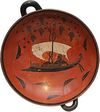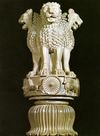MT Flashcards
(68 cards)
Dipylon Vase

8th c. BCE
geometric
“Let no one enter here who is ignorant of geometry” - Plato’s academy
bands of mourning figures with a dead guy in the middle
found in a cemetary
spirals and geometric shapes incl. greek spiral
one of first styles to re-emerge after dark age, after protogeometric.
uses brushes and compasses on a pottery wheel.
presents a narrative
simplistic, but regular and symmetrical geometric figures – cannot be too complex with black figure pottery – led to the development of red figure pottery.
re: geometric vessels : “Spaces between horizontal bands are filled with lozenges, checkers, chevrons, squares, scrolls of Greek fret patterns and sometimes men and animals” (Honor and Fleming 117)
Dionysos in a Boat

SIGNED by Exekias
Black Figured Kylix
c. 540 BCE
Black figure pottery
notable because it show motion in the sails
Kore
(Lady of Auxerre)

650 BC
Lime Stone
Stiff
Meant to be approached frontally
Originally brightly painted
modestly clothed
archaic smile
likely found in a necropolis (https://www.louvre.fr/en/oeuvre-notices/statue-woman-known-lady-auxerre) – funary?
Kouros
(Standing Youth)

600 BC
Marble
male sociocultural ideal
man at height of youth and masculinity
naked because muscles to show this off
Kritios Boy

480 BC
Marble
FIRST USE OF CONTRAPPOSTO
inlaid with glass eyes
“What is more notable is that the torso is no longer concieved as a kind of chart or diagram (as most Archaic Kourai) but as a single organic form in which muscular rhythms find their natural balance” (Honor and Fleming 123).
A Bronze Foundry

Red Figure decoration on Kylix
490-480 BC
Depicts lost wax casting
how sculptures were made (in pieces, from drawings).
Red figure pottery
The Riace Warriors A & B

5th c BC
Bronze with bone, glass paste, silver, and copper
fisherman pulled out with net in 60s(?)
Exaggeration to create “perfection”
***Talk about photoshop/plastic surgery ***
use of different metals for different body parts
maturity shown through beard (abnormal for greeks bc they liked young men )
Parthenon seen fron W. Iktionos, Kallikrates, and Karpion

447-432 BC
Marble
collonades
arcades
doric columns (ext)
Ionic (int/ext)
Corinthian (int)
in acropolis
Curved stylobate - entassis
*Visually perfect but not structurally
4 columns in corners are bigger
Pediments: athena v. poseidon , who should be patron of Athens.
Phidias, Lapith and Centaur Metope

447-432 BC
Marble
Allegoy - Greeks will always be superior - Propaganda
Wet drapery style
Civilization v barbarian
allegory of greek war with persians (Honor and Fleming)
Aphrodite of Cnidus
(Colonna Venus)

340-330 BC
Marble
First nude lady
OK for her to be nude because she’s covering her bits and looking away
contrapposto
created 2 statues – 1 nude and 1 clothed
Sleeping Satyr or Barberini Faun

c. 220 BC
complete security
no fear or modesty
casual and sensual
*is this for public consumption*
sleeping figures as allegory — lust???
Dying Gaul

230-220 BC
Roman marble copy of a bronze original
history is written by the victor
sense of dignity
respect
fought naked, hair, torc, face, signs of gaul
propaganda
The Laocoön Group

1st century Bc
Marble
agony
???? REVIEW
Int. of the tomb of the reliefs

c. 300 BC
Cerveteri Italy
Like a house
Had house stuff
they got buried here
stucco reliefs in a few colours
paintings of deities
Arch of Titus

81 CE
Rome
titus was an antisemetic ass
visual propaganda
near colosseum
triumphal arch
concrete and marble
winged victory figures
reliefs 71 ad of killing jews
nero’s son vespasion and his son titus were deified.
built by titus’s unpopular brother to gain power
shows what they looted.
Basilica of Maxentius & constantine

307-12 CE
Rome
lg meeting place
law courts
central nave
side aisle
apse
sig, bc was the basis for modern churches
Temple of Fortuna Virilis

Late 2nd C CE
Rome
temples becoming less important as architecture but gods still important.
pediment and frieze (grk) + porch (etruscan) = Roman
Pantheon

c. 118-28 CE
Rome
Built by Hadrian
Only building continuously used and completely intact
site of earlier temple dedicated by Agrippa
Original didn’t have done.
Dome is perfectly circular, 143’
oculus 27’ - compression ring and lighting
portico
gabled roof
bronze double doors 25’ tall, 20 tons/ea
81 niches. butresses & burial chambres
as height incr. thickness decr.
coloured marble to be “delightful”
donated to pope boniface who removed the ‘pagan filth’.
Frigidarium, The baths of Diocletian

c. 298-305 CE
Rome
Converted by Michaelangelo into the church of S. Maria degli Angeli
Colosseum
(Flavian Ampitheatre)

c. 70-82 CE
Rome
First permanent large scale roman arena
rich @ bottom poor @ top
free
doric @ bottom,
ionic @ 2
corinthian @3
originally covered in marble.
gladiators fought 106-114
2300 ppl
no floors in it now, can see lifts etc.
fighting ended bc telemachus (monk) tried to stop fighting and got stoned and then the emperor banned gladitorial games.
Colossal Head

Olmec
La Venta, Mexico
1500-800 BC
Basalt & Jadeite
transported over 100km over swampland
mayans usually did architecturally related work, and olmecs usually did freestanding forms in the round, portraits of rulers?
Stepped Pyrampid at Tikal

Guatemala
Pre-800 BC
9 courts connected by causeways
big stone structures are most of what survives because stone was dedicated for the gods.
most architectural detail is on the outside because thats where the public rites happened.
Bloodletting Ritual
(Lintel 24)

Lintel from Yaxchilan Mexico c. 725 BC
Limestone
relief carving
nobles standing over in regalia
propaganda?
king stands over queen while she cuts tongue with bits of obsidian.
Coyolxauhqui

Late 15th c
stone
broken body of daughter of earth mother goddess coatlicue after she is killed by brother.
shows shame in nudity, the act of trying to kill
shows rightfulness of brother
































